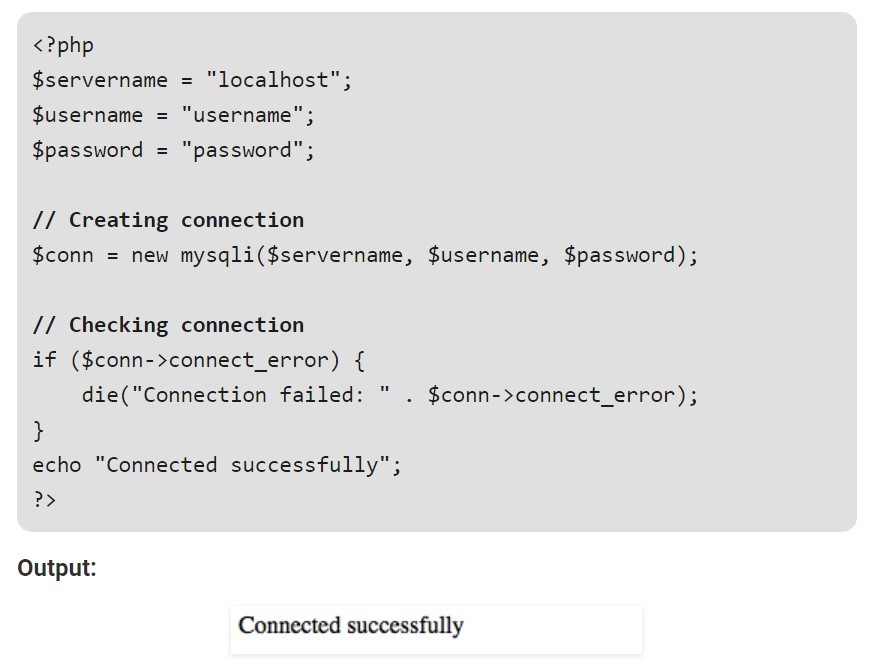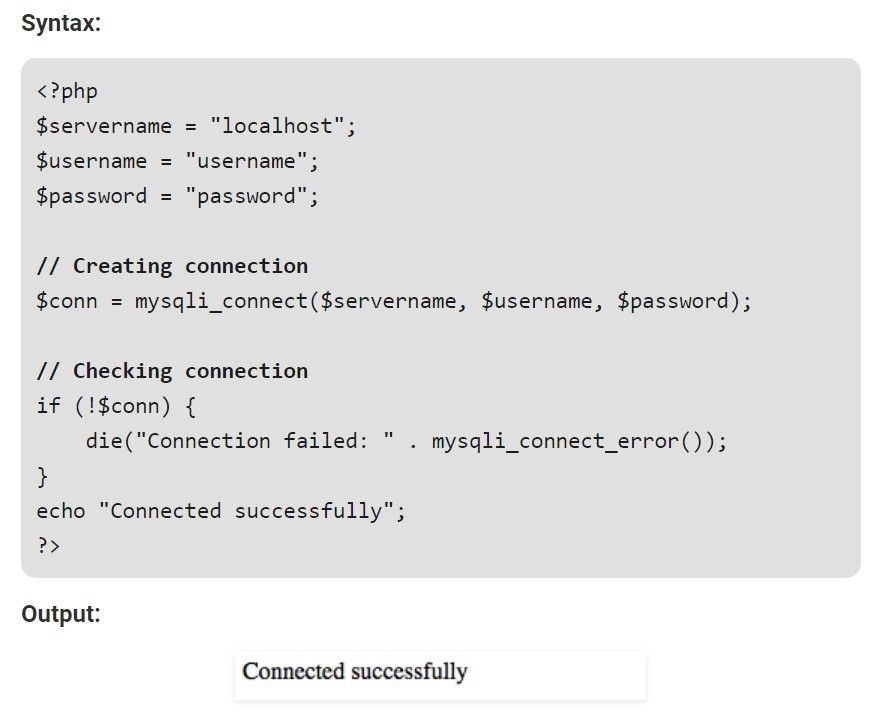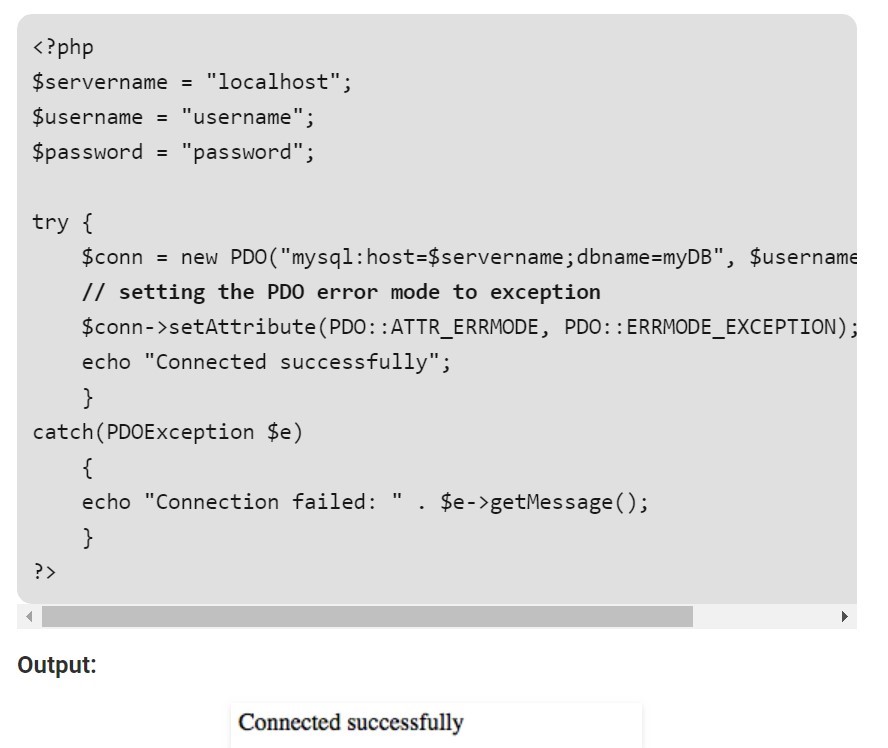To make optimum usage of any database, one should be able to manipulate it as required. The best way to manipulate and manage the databases you created is to connect your database with PHP. First, let us understand what PHP is. PHP is like a control panel that can be used to manage your database. Connecting to PHP allows you to retrieve data from databases as needed for a particular query. MySQL is the most popular open-source RDBMS, which can be easily connected to PHP. MySQL organizes data in tables using a row and column structure. As a result, MySQL is suitable for both small and large applications, and it operates on the server.
ADVERTISEMENT Popular Course in this category PHP DEVELOPER - Specialization | 8 Course Series | 3 Mock TestsStart Your Free Software Development Course
Web development, programming languages, Software testing & others
How to Create a Database?
Creating a database in MySQL is as simple as performing a single command in SQL. For example, an easy query of “[CREATE DATABASE]” can be used for database creation for beginners. Another database creation option is using another query as “[CREATE SCHEMA].”
For instance, if you wish to create a database named “movies,” you can achieve this by executing the command CREATE DATABASE movies;

Adding more parameters and avoiding confusion between existing databases on a single MySQL server can use the command “[IF NOT EXISTS].” This query checks whether any existing database has the same name. If yes, the command will not execute the creation of the database. On the other hand, if there is no such conflict of database names, the below command will execute and create a database. Although “[IF NOT EXISTS]” is non-mandatory, it is a good practice.

This newly created database will be empty, waiting for the inclusion of tables with data. SQL command for tables is a simple query “[CREATE TABLE]” with syntax as below.
This newly created database will be empty, waiting for the inclusion of tables with data. SQL command for tables is a simple query “[CREATE TABLE]” with syntax as below.

Connecting Database to PHP
PHP versions below 5 use MySQL extension. But this extension was derogated in 2012.
The 5th version of PHP and newer versions can work with below:
1. MySQLi extension
2. PDO (PHP Data Objects)
According to their own supremacy and needs, any of the above options can be utilized.
The MySQLi extension can be used only with MySQL databases, whereas PDO can connect with 12 different database systems. So, PDO might be helpful if one is switching databases as it only requires changing a few connections. But in the case of MySQLi, we need to write the entire code and query to switch databases. Enabling MySQLi on PHP is necessary to work with MySQLi. MySQLi also provides a procedural programming interface along with an object-oriented one. PDO and MySQLi support prepared statements, which are crucial aspects of web security.
Working with PHP and MySQL
PHP and MySQL are some of the most common stacks for web development.
- Object-oriented MySQLi
- Procedural MySQLi
- PDO
To start with any of these, you must know some essential details, such as your database system’s server address, username, database name, and password. Mainly, we will be using mysqli_connect in all three procedures. This command sets up a connection between the database and PHP. First of all, we have to create a separate connection file. This saves time in writing code every time you want to insert data and information from the database and insert this data in multiple files.
We can use the PHP file connection name along with the include function and insert the data instead of rewriting the code each time. This is also useful when transferring your entire project from one system to another. When you change the values in one file, it automatically changes all values in every file and saves you the effort of making changes in every file. Once you have successfully established the connection, you can employ various methods to interact with the database.
Let’s look into each of them one by one:
1. Using Object-Oriented MySQLi
This can be used to build an association with the database using PHP script using the following syntax.

Explanation:
- Localhost is the location of the server. The host can be something else, but the server runs on the localhost in most cases.
- The username is the root, and the password; is the same which you use for php admin.
- To establish this link, provide the necessary details such as localhost, username, and password. This will create an instance of MySQLi, resulting in a successful connection.
2. Using MySQLi Procedural
To establish a connection between the database and PHP using MySQLi procedural, you can follow the procedure outlined below:

Explanation:
- The main difference for the procedural procedure is that it uses the function mysqli_connect, which fetches the necessary details of the host, username, and password, etc. When successfully connected, it will provide a link identifier.
3. Using PDO
PDO represents PHP Data objects. So in this process of creating a connection, PHP data objects are used as below:

Explanation:
- The exception function in PDO assists in throwing and handling any exceptions that may arise while establishing connections, ensuring proper management of any encountered issues.
All the above methods help access and manage the database you need.
Checking the Connection:
Below syntax can be used to check whether your connection is successfully connected.

Db_connection is the php file name.
Ending the Connection:
Once you establish a database connection using PHP scripts, you should close the connection once your work is finished. With an assumption of reference to the connection stored in the $ conn variable, below are the closing syntax used in the above-given procedures.
- Using MySQLi object-oriented procedure

- Using MySQLi procedural procedure

- Using PDO procedure

Conclusion – How to Connect Database to PHP?
Accessing and managing your database becomes straightforward when you establish a connection using PHP. It also offers a variety of ways to establish this connection to suit varying levels of requirements. After establishing the connection, you can actively execute queries to extract data from the tables. You can easily print out this information. Closing the connection is an essential part of connecting the database to PHP, and it should be done once your work is completed.
The above is the detailed content of How to Connect Database to PHP?. For more information, please follow other related articles on the PHP Chinese website!

Hot AI Tools

Undress AI Tool
Undress images for free

Undresser.AI Undress
AI-powered app for creating realistic nude photos

AI Clothes Remover
Online AI tool for removing clothes from photos.

Clothoff.io
AI clothes remover

Video Face Swap
Swap faces in any video effortlessly with our completely free AI face swap tool!

Hot Article

Hot Tools

Notepad++7.3.1
Easy-to-use and free code editor

SublimeText3 Chinese version
Chinese version, very easy to use

Zend Studio 13.0.1
Powerful PHP integrated development environment

Dreamweaver CS6
Visual web development tools

SublimeText3 Mac version
God-level code editing software (SublimeText3)

Hot Topics
 How to upgrade PHP version?
Jun 27, 2025 am 02:14 AM
How to upgrade PHP version?
Jun 27, 2025 am 02:14 AM
Upgrading the PHP version is actually not difficult, but the key lies in the operation steps and precautions. The following are the specific methods: 1. Confirm the current PHP version and running environment, use the command line or phpinfo.php file to view; 2. Select the suitable new version and install it. It is recommended to install it with 8.2 or 8.1. Linux users use package manager, and macOS users use Homebrew; 3. Migrate configuration files and extensions, update php.ini and install necessary extensions; 4. Test whether the website is running normally, check the error log to ensure that there is no compatibility problem. Follow these steps and you can successfully complete the upgrade in most situations.
 How do I prevent cross-site request forgery (CSRF) attacks in PHP?
Jun 28, 2025 am 02:25 AM
How do I prevent cross-site request forgery (CSRF) attacks in PHP?
Jun 28, 2025 am 02:25 AM
TopreventCSRFattacksinPHP,implementanti-CSRFtokens.1)Generateandstoresecuretokensusingrandom_bytes()orbin2hex(random_bytes(32)),savethemin$_SESSION,andincludetheminformsashiddeninputs.2)ValidatetokensonsubmissionbystrictlycomparingthePOSTtokenwiththe
 PHP beginner guide: Detailed explanation of local environment configuration
Jun 27, 2025 am 02:09 AM
PHP beginner guide: Detailed explanation of local environment configuration
Jun 27, 2025 am 02:09 AM
To set up a PHP development environment, you need to select the appropriate tools and install the configuration correctly. ①The most basic PHP local environment requires three components: the web server (Apache or Nginx), the PHP itself and the database (such as MySQL/MariaDB); ② It is recommended that beginners use integration packages such as XAMPP or MAMP, which simplify the installation process. XAMPP is suitable for Windows and macOS. After installation, the project files are placed in the htdocs directory and accessed through localhost; ③MAMP is suitable for Mac users and supports convenient switching of PHP versions, but the free version has limited functions; ④ Advanced users can manually install them by Homebrew, in macOS/Linux systems
 How to combine two php arrays unique values?
Jul 02, 2025 pm 05:18 PM
How to combine two php arrays unique values?
Jul 02, 2025 pm 05:18 PM
To merge two PHP arrays and keep unique values, there are two main methods. 1. For index arrays or only deduplication, use array_merge and array_unique combinations: first merge array_merge($array1,$array2) and then use array_unique() to deduplicate them to finally get a new array containing all unique values; 2. For associative arrays and want to retain key-value pairs in the first array, use the operator: $result=$array1 $array2, which will ensure that the keys in the first array will not be overwritten by the second array. These two methods are applicable to different scenarios, depending on whether the key name is retained or only the focus is on
 How to use php exit function?
Jul 03, 2025 am 02:15 AM
How to use php exit function?
Jul 03, 2025 am 02:15 AM
exit() is a function in PHP that is used to terminate script execution immediately. Common uses include: 1. Terminate the script in advance when an exception is detected, such as the file does not exist or verification fails; 2. Output intermediate results during debugging and stop execution; 3. Call exit() after redirecting in conjunction with header() to prevent subsequent code execution; In addition, exit() can accept string parameters as output content or integers as status code, and its alias is die().
 Applying Semantic Structure with article, section, and aside in HTML
Jul 05, 2025 am 02:03 AM
Applying Semantic Structure with article, section, and aside in HTML
Jul 05, 2025 am 02:03 AM
The rational use of semantic tags in HTML can improve page structure clarity, accessibility and SEO effects. 1. Used for independent content blocks, such as blog posts or comments, it must be self-contained; 2. Used for classification related content, usually including titles, and is suitable for different modules of the page; 3. Used for auxiliary information related to the main content but not core, such as sidebar recommendations or author profiles. In actual development, labels should be combined and other, avoid excessive nesting, keep the structure simple, and verify the rationality of the structure through developer tools.
 How do I access session data in PHP?
Jun 30, 2025 am 01:33 AM
How do I access session data in PHP?
Jun 30, 2025 am 01:33 AM
To access session data in PHP, you must first start the session and then operate through the $_SESSION hyperglobal array. 1. The session must be started using session_start(), and the function must be called before any output; 2. When accessing session data, check whether the key exists. You can use isset($_SESSION['key']) or array_key_exists('key',$_SESSION); 3. Set or update session variables only need to assign values ??to the $_SESSION array without manually saving; 4. Clear specific data with unset($_SESSION['key']), clear all data and set $_SESSION to an empty array.
 What are recursive functions in PHP?
Jun 29, 2025 am 02:02 AM
What are recursive functions in PHP?
Jun 29, 2025 am 02:02 AM
Recursive functions refer to self-call functions in PHP. The core elements are 1. Defining the termination conditions (base examples), 2. Decomposing the problem and calling itself recursively (recursive examples). It is suitable for dealing with hierarchical structures, disassembling duplicate subproblems, or improving code readability, such as calculating factorials, traversing directories, etc. However, it is necessary to pay attention to the risks of memory consumption and stack overflow. When writing, the exit conditions should be clarified, the basic examples should be gradually approached, the redundant parameters should be avoided, and small inputs should be tested. For example, when scanning a directory, the function encounters a subdirectory and calls itself recursively until all levels are traversed.






